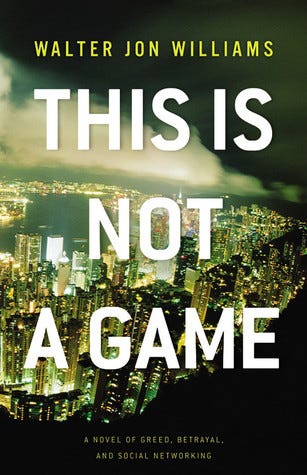Right before WorldCon became an open vortex of collectivist politics and furry pronouns, I attended the Reno 2011 spectacle and was gifted several paperbacks by different publishers. THIS IS NOT A GAME was one of the few that was worth the read, and has merited a recommendation over the years.
The Story
This book starts off with one of the most intriguing opening chapters I’ve ever read: a programmer goes into work, boots up his computer, decides to check his bank account, and sees that four billion dollars have been deposited. His reaction?
“This has got to stop.”
What’s going on? Well, it’s hard to explain without giving away a shocking third-act reveal, and that alone is worth the time it takes to read the book. Basically the central characters are game developers, and they spend 90% of their waking hours in cyberspace. They were friends in their early days but have since gone in different directions. Three are very successful, while the other is forced to grind out as living as a “ninja” and a “farmer” in MMO games like World of WarCraft.
The “farming” aspect of MMO games plays a big role in this story. For the uninitiated, “farmers” are RPGers who spend all their time collecting in-game money and then selling it online for real-world cash. Pretty much every MMO has rules against it but it still happens, as there are always people looking to shortcut their way to the top in these worlds.
That desire has created an underground market for fantasy cash. A market hot enough to kill for. When one of the original four developers gets murdered, the others realize they’re not far behind, and have to figure out how to save their own necks.
This is the kind of book that I might NEVER have picked up on my own, yet once I started, I blew through it and kept thinking about it.
The Characters
Dagmar is a single woman in her late 20s, and she gets most of the screen time in this story. Her introduction has her stranded in a top-floor hotel room in a third-world country whose economy has just collapsed. As Dagmar is a developer of “alternate reality gaming,” her rescue comes in the form of hundreds of gamers from around the world, figuring out how to get her to safety. Once she’s back on US soil, she’s got to figure out what went wrong in southeast Asia.
BJ is the man who fell out after he broke some rules in the early days. Now he’s a call-center grunt and a ninja, but he’s looking to make his way back into the group as they struggle to figure out what’s crashing world economies—and who’s trying to kill the developers.
Charlie is the venture capitalist who funded the group’s projects in the beginning, and now he’s embroiled in the controversy that threatens all their lives. Dagmar trusts Charlie and BJ, even if they don’t like each other.
Rounding it all out is Austin, who unfortunately dies early on, but left some clues that will help the others resolve this overbearing threat.
Having known a couple of developers and coders in my college days, I really liked how spot-on these characters were in terms of their portrayal. I kept my emotional investment in their adventure because they felt authentic to me.
The World
Ostensibly this is set in our own world. The speculative element is the “alternate reality gaming,” which is something like old-fashioned turn-based story RPGs, with clues in the real world.
The games that Dagmar develops require casting, photography, cyphers, and more. Images get posted to forums, along with videos and fake articles about real events or places. Players get cryptic clues a la Dan Brown novels, and have to work together across chat rooms to decipher it all.
And apparently this is a legit type of gaming that I’d never played nor heard of prior to reading this book. Williams explains it all well enough to the unfamiliar reader without excessive info-dumping, so even if you’re an outsider like me, you can follow it with ease. Very cool stuff.
The Politics
This book doesn’t concern itself with politics. It’s much more about economics and interpersonal relationships. You get real characters in a fascinating gaming subculture and no soapbox moments about climate change or gender binaries or whatever.
Content Warning
Profanity up to the F-bomb, and some sensual humor. (After Dagmar’s rescue, she’s gifted a leatherbound copy of sexual fanfic that the gamers wrote about her during her ordeal, because gamers.)
Who’s It For?
This book sits right on the intersection of sci-fi readers and thriller fanatics. It moves much more like the latter, while bringing in plenty of elements of the former to keep it from being a generic grocery store checkstand book.
Why Read It?
It’s the kind of thriller that feels like it could really happen, with all of the devious moves perpetrated by the RPG nerds you know in the flesh. Between that and the cool idea of “alternate reality gaming,” this one kept me intrigued and I blew through it in a couple of days. Give it a shot.
Thank you for reading Upstream Reviews. This post is public so feel free to share it.




